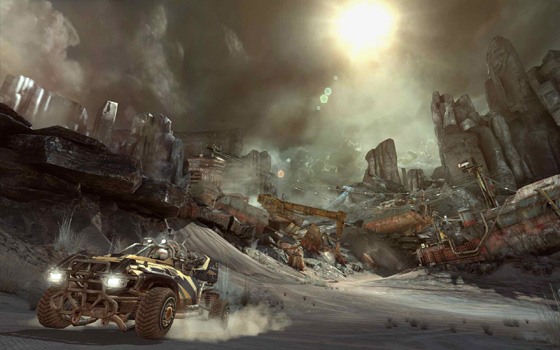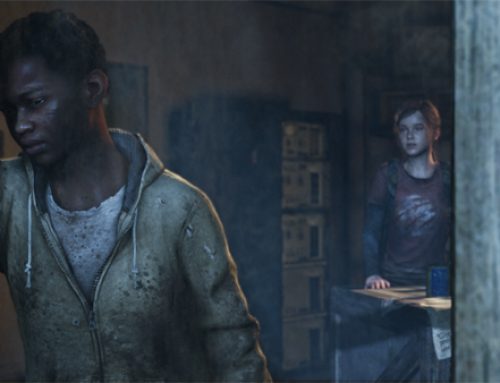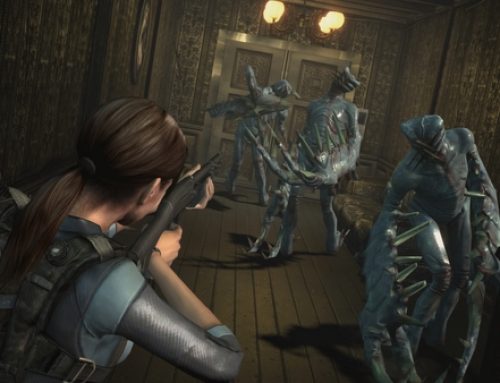This week’s newspaper column is a preview of three nonsequels coming out this fall, “Dead Island,” “Rage” and “Dark Souls.” If you missed it, I took a longer look at “Dead Island” a while back. I had more I could say about “Rage” than would fit in the paper, as well, so here’s a longer look at that game, which is due Oct. 4 for PC, Xbox 360 and PlayStation 3.
You could say Id Software, the studio behind “Wolfenstein,” “Doom” and “Quake,” knows its first-person shooters. So when the chance came to spend a few hours with its next project, “Rage,” I jumped at it. I spent about three hours playing through the first 90 to 120 minutes of the campaign at a media event last week in San Francisco, pausing to ask the developers a few questions about what I’d seen and experienced.
The single-player game opens with the main character being jostled out of a subterranean “ark” by seismic activity. Looking around the inside of the facility in which you’ve been cryogenically frozen, it’s pretty clear right away you’re the only survivor.
When you come to the surface, you discover much has changed while you’ve been out. The earth is a postapocalyptic, desert wasteland. Luckily, there’s a guy named Dan Hagar there to blast the bandit who attacks your bleary-eyed wanderer. Hagar, voiced by John Goodman in an inspired bit of casting, tells you to hop into his vehicle and spirits you away.
Dan, who lives on a remote, ramshackle compound with his family, serves as the game’s first quest giver and serves to orient players to the world. By performing missions for Dan and the people he introduces you to, you’ll end up with your first several weapons, your first vehicles and your first bit of context on the world around you.
The stranger-in-a-strange-land feel that your interactions with Dan and other NPCs have reminded me a little bit of Bethesda Softworks’ “Fallout” games. (Bethesda is publishing “Rage,” so there are similarities on the business end, too.)
There were also hints of Mike Judge’s movie “Idiocracy,” in which Luke Wilson plays a soldier who hibernates for 500 years and wakes up to find out he’s easily the smartest person alive. The people I met in “Rage,” though plenty smart, had a bit of a survivalist redneck mentality to them, referring to my futuristic-looking armor as outdated, even though it appeared to be much more technologically advanced than anything they were wearing. Nonetheless, my character eventually heeded their advice to swap out his clothes to better help him stay incognito.

The vehicle controls in "Rage" felt responsive and intuitive, not always a given in first-person shooters.
“Rage” has the trappings of an open world game. You’ll be driving gun-mounted vehicles around large, open areas to get to the next quest. Though there’s a bit of a go-anywhere, do-anything feel to the game, I got the sense that most players would be taking roughly the same path though the world.
While you get quests from Dan and other non-player characters, the whole “quest” set-up felt a lot more like what you get in “Borderlands” than what you get in a more nuanced game like “Fallout 3.” From time to time, characters will offer you quests and you’ll be given the option to accept or decline. But if you decline, the quest is still there when you come back later, Id President Todd Hollenshead told me. The option to decline quests is more a matter of giving players another option to manage all their quests, Hollenshead explained. I found myself hitting “accept” for everything, something I’ll expect most players will do because the game lets you change your active quests in the menus, anyway. There are no factions in the game to worry about, so why decline quests at all?
A couple of aspects of “Rage” felt a bit odd. For one thing, even though there were guns all around me, I could only acquire new weapons by performing quests or buying them. It’s kind of weird when you have a pistol and you kill a guy who’s carrying an assault rifle, but you can’t pick it up yourself and use it. The decision helps balance the game and keeps you from amassing too powerful an arsenal too early, but in 2011, it feels like a relic.
Even though you can’t scavange weapons, you can search enemies and various objects for bullets, money and components used to craft various items. The crafting system becomes available as you perform quests and unlock various recipes. In my playthrough, I unlocked a few simple items such as bandages for healing wounds and a device that opened locked doors.
The other aspect of “Rage” that felt weird is its mute hero in a game in which you effectively wake from a long slumber. If I went to bed tonight and woke up 500 years from now, I’d probably have a few questions when I woke up. Instead of getting to ask them, I had to pick up important background information from snippets of conversation. Dan Hagar and other characters make references to the “authority,” which sounds like a sinister, dictatorial presence, but I still had no idea who those people were at the end of my play time.
[gametrailers 718590]
There’s something very video gamey about mute heroes. “Rage’s” strong, silent hero works in that he allows Id to throw lots of action at players without getting bogged down in exposition, but it’s the kind of thing that’s weird if you pause to think about it, or if other characters’ words or actions draw attention to it.
Gameplaywise, “Rage” felt well-tuned and tight. By the end of the demo, I’d acquired a pistol, shotgun and sniper rifle, plus an assault rifle and crossbow that I didn’t really get to use. (I acquired the crossbow right at the end of my demo, and the assault rifle before journeying to a small settlement in which I didn’t do any fighting.) Everything felt well-balanced and smartly tuned. The pistol, while underpowered, allowed me to squeeze off a lot of rounds but took a lot of hits to kill something. Bizarrely, it seemed to take two headshots to kill bandits, three if you count the first hit that knocked off their helmets. The shotgun, however, was pretty much a one-shot kill once you got in close.
Each weapon has several ammo types available, at least some of which can be built through crafting. In this respect, the game reminded me a little bit of the “BioShock” titles, where you have to decide when best to deploy your higher-powered rounds.
Id has put a lot of emphasis on the vehicles in “Rage.” Not only do you use them to travel long distances, you’ll be shooting it out with bandits, participating in races and upgrading them in auto shops. They also form the basis of one of the game’s multiplayer modes. (The other is a separate co-op campaign that exists on the periphery of the main storyline.) I found vehicle handling to be a snap, thanks to Id’s decision to map the controls in such a way that it felt more like a driving game. The right trigger accelerates while the left trigger brakes and puts the vehicle in reverse. Other buttons can be used to fire weapons and stop on a dime. At one point, I crashed into a barricade and my character went flying over the handlebars of his ATV, reminding me a bit of the “FlatOut” racing games.
Near the end of my demo, as I wrapped up my tasks for Dan Hagar, I hit the town of Wellspring, which clearly will serve as a hub area once you finish all the beginning, expository stuff. Once in Wellspring, I was able to accept missions from a bounty board, participate in my first race, grab a Vault Boy bobblehead off of the sheriff’s desk and acquire my first outfit.
The three outfits available gave my character different upgrades. The Wastelander bestowed a discount on cash purchases, while the Roughneck outfit made you more resistant to damage. I opted for the Fabricator suit, which enhances the items you craft from components.
Overall, I had a great time with “Rage.” Despite some limitations with dialogue, it seems like Id has crafted an interesting world with a backstory worth discovering, and the gunplay is as satisfying as you’d expect from a developer with such a rich pedigree. Though I only took part in one race and a bit of vehicular combat, the level of polish that this portion of the game appears to have is a pleasant surprise. Often, I struggle a bit to drive in shooting games because vehicle controls seem like they were an afterthought to the developer. That didn’t seem to be the case with “Rage.” I’m looking forward to getting more time with it in October.
Follow Eric Wittmershaus on Twitter and join the GameWit blog group on Facebook.




